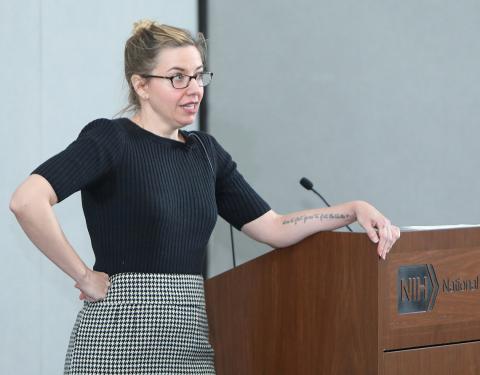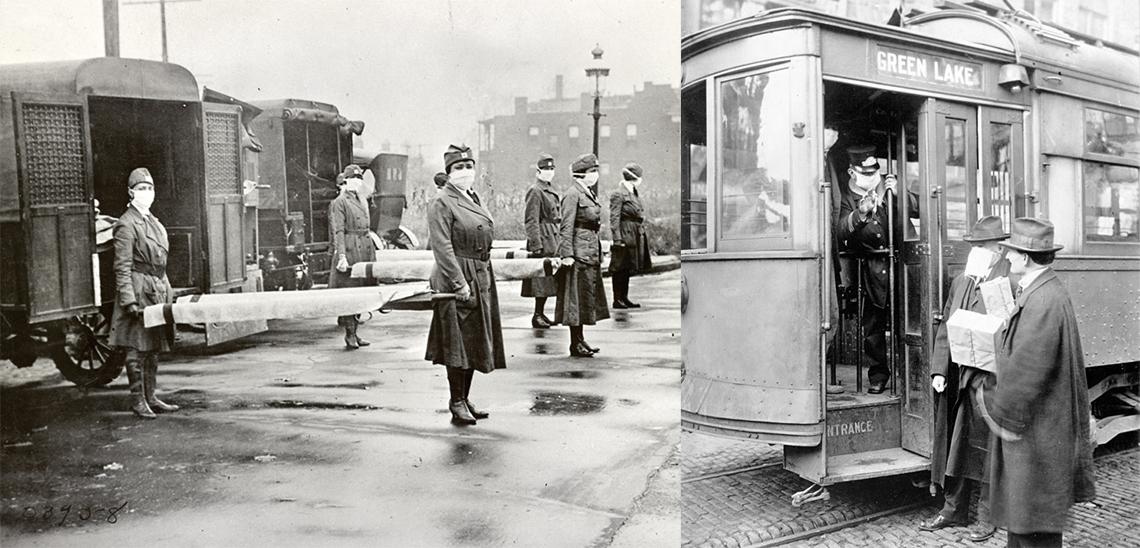Not a Fair Fight
‘Viruses Don’t Play By Our Rules,’ Says MacPhail

Photo: Chia-Chi Charlie Chang
Those who don’t learn from history are doomed to repeat it, or so the saying goes. So what can past worldwide pandemics teach us about future deadly outbreaks and the systems we’ve developed to combat them? Dr. Theresa MacPhail, a medical anthropologist who lived in China just after a deadly virus struck there, visited NIH recently to share her insights into the “Evolution of Viral Networks: H1N1, Ebola and Zika.”
“Outbreaks are about more than just biology and epidemiology,” she said. “Our responses to outbreaks are conditioned by what we know about past outbreaks. They rely upon institutions and structures put in place as a result of prior outbreaks and are often as much about politics and economic constraints as they are about science.”
MacPhail moved to Hong Kong in 2003, just as 37 countries around the world were recovering from severe acute respiratory syndrome, or SARS, which originally broke out in south China and killed nearly 800 people. Before the pandemic was contained, more than 8,000 cases had been reported globally. Two years later, when bird flu erupted, “the government’s response was swift and unforgiving,” MacPhail said. “SARS was a dramatic event in China and colored the public health response to everything that followed it.”
MacPhail’s lecture was the keynote of “Viral Networks: An Advanced Workshop in Digital Humanities and Medical History,” sponsored jointly by the National Library of Medicine and the National Endowment for the Humanities (NEH). NEH and NIH recently extended their 6-year-old collaboration with a new memo of understanding through 2021.

Photo: Library of Congress
“I’ve recognized through time that humanities have much to offer us as we bring a scientific and engineering approach to thinking about that which can only be experienced by humans,” noted NLM director Dr. Patricia Flatley Brennan, in opening remarks.
Delivering her lecture, coincidentally 100 years to the day of the start of the killer 1918 influenza pandemic, MacPhail, assistant professor of science and technology studies at Stevens Institute of Technology, said, “SARS had proven we needed a more robust international response system…What bird flu proved was that we needed a more robust surveillance system. The global community couldn’t afford to be taken by surprise if another highly infectious pathogen were to emerge.”

Photo: Chia-Chi Charlie Chang
By 2009, when a novel strain of H1N1 influenza broke out in Mexico, an international public health response system—a so-called “viral network”—was experience- informed and ready for the world stage, MacPhail said. Given lessons from SARS and bird flu, would the system master the challenges presented by a fast-moving, mostly unpredictable infection?
MacPhail defines a viral network as “any group of people, institutions, technologies and other living and non-living things—like viruses—that are interconnected in order to produce information or knowledge. The network exists to create, revise and transmit information to get everyone on the same page. That’s its whole function. And that function is critical to us being able to act…The viral network is a super-organism that relies upon its individual parts and yet is able to transcend them.”
MacPhail’s lecture pitted the viral network’s 2009 performance—she wrote a widely regarded book, The Viral Network: A Pathography of the H1N1 Pandemic, about it—against two more recent pandemics: the 2014-2015 Ebola crisis and the 2015 Zika outbreak.
She focused on three aspects of the viral network—lab work, surveillance and information-sharing/coordination systems.
“We have to think about outbreaks, epidemics and pandemics holistically,” she said. “We have to look at everything—history, politics, economics, biology, culture—all at once in order to understand not only what happened, but also what is happening and what is likely to happen in the future.”
Had 2009 lessons produced any changes in the network? MacPhail asked. “Had the virus that is global health adapted, mutated or evolved to be better able to respond to large-scale highly transmissible infectious diseases?”
The reviews were somewhat mixed.
“Lab science forms the core of the entire super-organism that is global health,” argued MacPhail, who in 2009 worked in the global disease detection unit of the Centers for Disease Control and Prevention in Atlanta and witnessed the culture of pathologists and epidemiologists first-hand in real time as H1N1 occurred.

Photo: Chia-Chi Charlie Chang
The genetic sequencing of H1N1 “was a watershed event,” she reported. “It was to date the fastest, most transparent production of phylogenetic information on any new virus that has ever taken place. Laboratories around the globe worked together pretty seamlessly to produce quality information—the viral network at its best.”
Labs remain the most adaptable segment of the global health system, she said. But, “lab capacity is always a problem during any outbreak of infectious disease, no matter where you are. Because of this, strengthening lab capacity has been a key focus of pandemic planning.”
Unlike the big-city emergence of H1N1 in Mexico, the first cases of Ebola occurred, in late 2013, in impoverished rural areas and initially were missed by the network. It wasn’t until May 2014 that a sentinel lab in Kinshasa, central Africa, sounded an alarm. A case reported in Sierra Leone in March had been ignored.
“Sporadic cases of Ebola are normal for certain locations,” so no red flags were triggered by the first cases, MacPhail explained. “That’s the real issue here—the viral network doesn’t reach everywhere…Clearly there are many gaps in our surveillance and lab capabilities.”

Photo: Chia-Chi Charlie Chang
Ebola, capitalizing on these system vulnerabilities, was able to get a foothold, she pointed out. For Zika, labs were deemed generally successful; however, political realities—the virus affected pregnant women and infants—intruded on surveillance and coordination efforts. Again, the infection largely won.
“Public health in all its forms is constantly focused on its past,” MacPhail said. “It tries to learn from its history but in doing so it often repeats the same mistakes.”
Having data and circulating it widely is not the same as having knowledge, she explained. Context is crucial, and that comes only from seasoned, expert analysts, who often are in short supply.
MacPhail said the narrative is the same for H1N1, Ebola, Zika—and in many ways for today’s H3N2 flu outbreak, which is swiftly showing itself to be the worst influenza epidemic in recent history.
“We’re bad at predicting because pathogens are great at surprises,” she said. “They pop up in weird places, at weird times and seem harmless…and we can’t care about everything. Our resources are limited. Global health makes choices about what to prioritize.”
Without more resources, surveillance capacity and expertise, MacPhail said, “we won’t see the next thing coming either.”
Reviewing how each pandemic played out, she made valuable observations: Chiefly, the network is not flexible enough to adapt quickly to ever-changing pathogens and conditions, and past information often can hinder as well as help in real-time crises.
“Viruses do not play by our rules,” she concluded. “They confound our expectations and force us to become like them in order to effectively battle them. The global viral network needs to keep evolving but clearly we need to start rethinking about how we do that.”
MacPhail’s lecture is archived online at https://videocast.nih.gov/summary.asp?Live=26977&bhcp=1.
